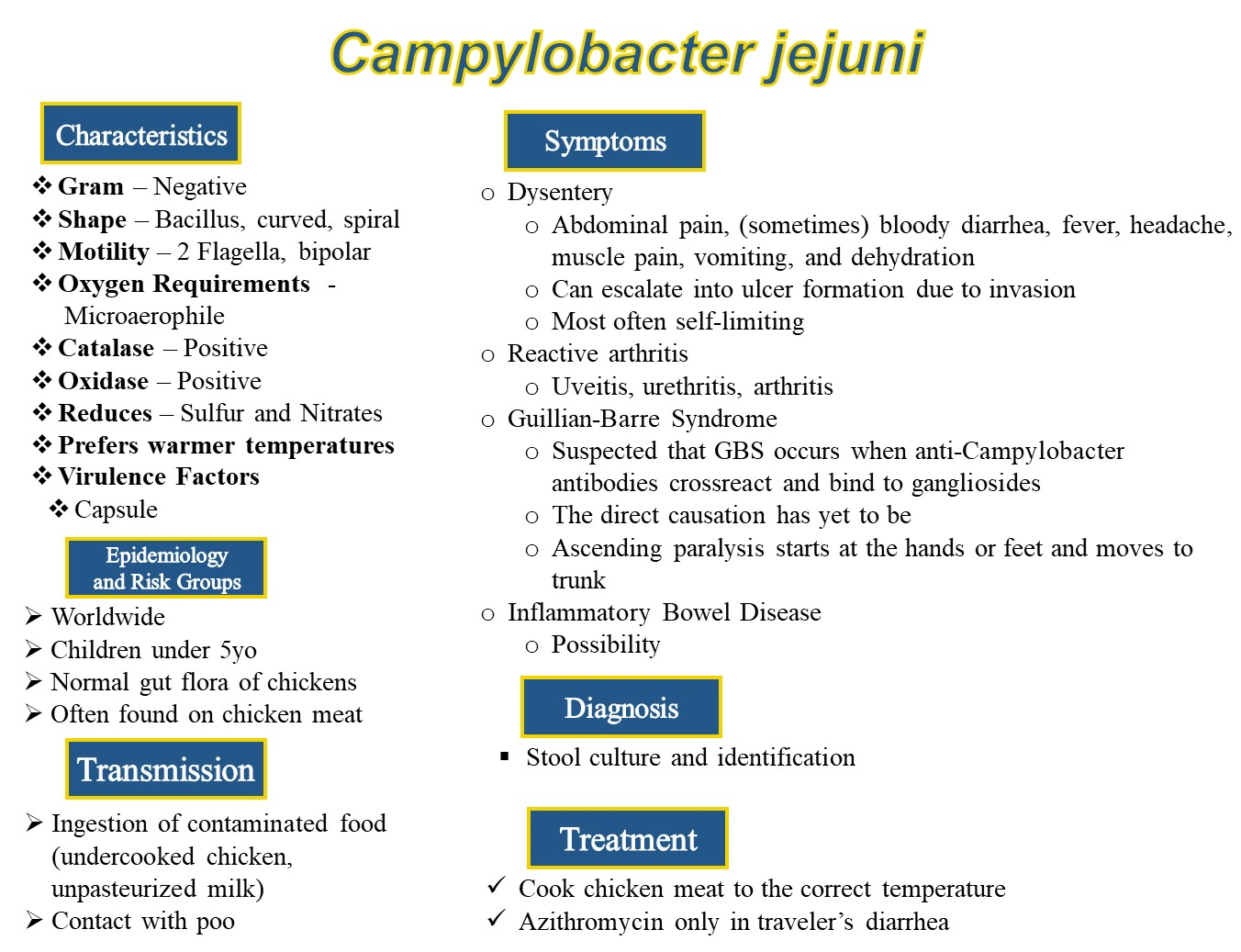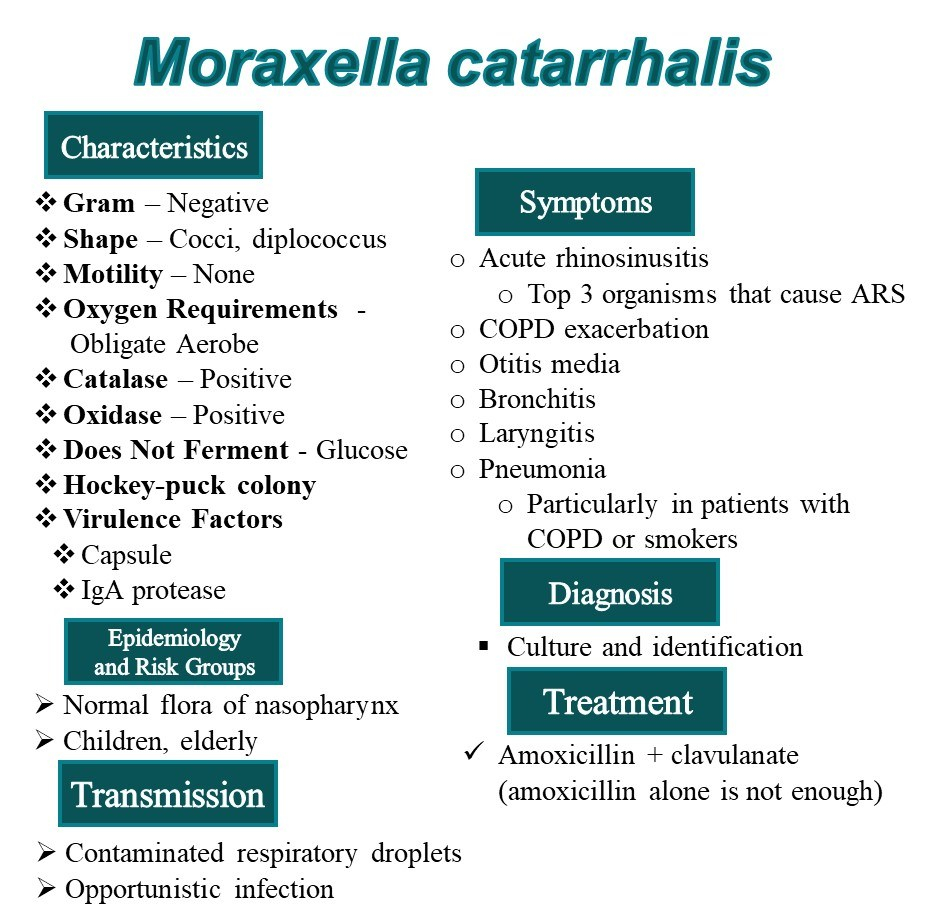Campylobacter jejuni is a common cause of diarrhea worldwide. It is usually a self-limiting infection that causes diarrhea for about a week. It is typically transmitted by consuming undercooked chicken. C. jejuni has been found on about 95% of the already packaged chicken meat in US grocery stores. The reason why it’s found on chicken meat is that it’s a common normal flora agent of the GI tract of chickens. It actually prefers their higher normal body temperature than our normal temperature. The good news, is that it’s a relatively delicate organism and can be killed by cooking. So cooking your chicken meat to the correct CDC recommended temperature is enough to destroy this organism.
It can start to invade the gastric mucosa, so sometimes there’s blood involved in the diarrhea. It has also been connected to very rare complications like reactive arthritis, Guillian-Barre Syndrome, and Inflammatory Bowel Disease; however, with how prevalent this organism is in our environment and food, it’s hard to say at this point.

Moraxella catarrhalis is a Gram-negative diplococcus that is one of the top causes of acute rhinosinusitis in the US. It was discovered by a Swiss opthomologist, Victor Morax, who named it catarrhalis because that means “flow down” as in lots ‘o snot.
It has an IgA protease which is perfect because it will infect the respiratory mucosa, where IgA is a great defense mechanism. One cool thing is that when you grow this organism on agar plates you can actually slide the colony around like a hockey puck, which is called the “hockey puck sign.”


A 46-year-old male presents to the emergency room with muscle weakness in both upper and lower extremities, and new-onset reduced mobility for the past 6 hours. He had a 24 hour period of watery diarrhea, nausea, and fever 10 days earlier. Vital signs are normal. Physical examination reveals that the cranial nerves were unaffected, and mental status is normal. Both nerves innervating the proximal and distal muscle groups of the upper and lower extremities affected revealed a 3/5 strength in all limbs. The paralysis continues to move up the limbs toward the trunk over the next 48 hours. Stool cultures reveal a thermophilic, spiral-shaped, Gram-negative, oxidase- and catalase-positive, but urease-negative organism. What is the most likely causative agent?
A. Helicobacter pylori
B. Campylobacter jejuni
C. Leptospira spp.
D. Treponema pallidum
First, diagnose the patient.
This patient is presenting with a new-onset weakness and paralysis that is moving from the extremities toward the trunk which is classic presentation for Guillian-Barre Syndrome. Therefore, what you need to do is apply the list of organism characteristics to the potential complication of GBS.
A. H. pylori is not a thermophilic organism; however, it is Gram-negative, helical, oxidase- and catalase-positive. It is urease-positive.
B. Camylobacter jejuni is associated with GBS, but this is a very, very rare complication of this infection. Typically it causes a self-limiting diarrheal disease that rarely needs intervention.
C. Leptospira spp. is a Gram-negative, helical, organism that usually presents with jaundice or meningitis.
D. Syphilis is a Gram-negative, spiral organism, but it is catalase- and oxidase-negative. It also doesn’t usually present with paralysis without causing any behavioral changes.
This patient was treated with intravenous human immunoglobulin G, and recovered fully within 3 weeks.
Therefore,

An 85-year-old female presented with a bloody cough, dyspnea, and fever for the past 5 days. Vital signs reveal a temperature of 97.2F, a blood pressure of 96/60 mmHg, a heart rate of 160 beats/min, a respiratory rate of 30 breaths/min, and oxygen saturation of 88% on room air. Physical examination revealed a disseminated petechial rash over the whole body, pulmonary auscultation showed diffuse rhonchi and diminished respiratory sounds at the left lung base. Laboratory test revealed leukocytopenia. Culture of the sputum revealed a Gram-negative diplococcus that grew on blood agar. What is the most likely causative agent?
A. Haemophilus influenzae
B. Streptococcus pneumoniae
C. Moraxella catarrhalis
D. Enterococcus spp.
First, diagnose the patient.
This patient is presenting with tachycardia, hypotension, tachypnea, and low oxygen saturation, hemoptysis, and dyspnea, which all suggest some sort of bacterial pneumonia.
The most common cause of bacterial pneumonia is Streptococcus pneumoniae but sputum cultures reveal a Gram-negative diplococci.
A. Haemophilus influenzae is a Gram-negative diplococcus that could cuase pneumonia, but it does NOT grow on blood agars, because it doesn’t have any hemolysins. It will only grow on chocolate agars because it needs those nutrients.
B. Streptococcus pneumoniae is a diplococcus that is the most common cause of pneumonia, but it is Gram-positive, not Gram-negative
C. Moraxella catarrhalis can cause pneumonia, is Gram-negative diplococcus that can grow on blood agar.
D. Enterococcus spp. *can* cause pneumonia, but it’s rare. It is also a diplococcus, but it is a Gram-positive.
Therefore,

References:
https://microbewiki.kenyon.edu/index.php/Moraxella_catarrhalis
https://cmr.asm.org/content/28/3/687
https://jmedicalcasereports.biomedcentral.com/articles/10.1186/1752-1947-4-101
https://academic.oup.com/cid/article/49/1/124/371116

